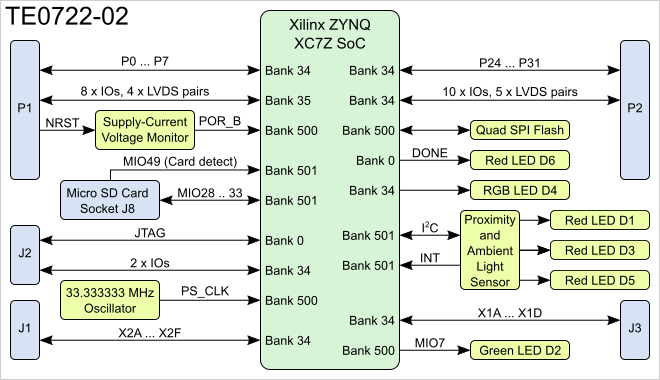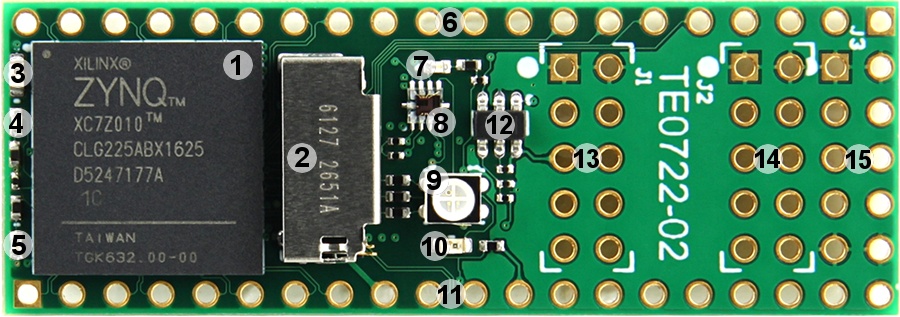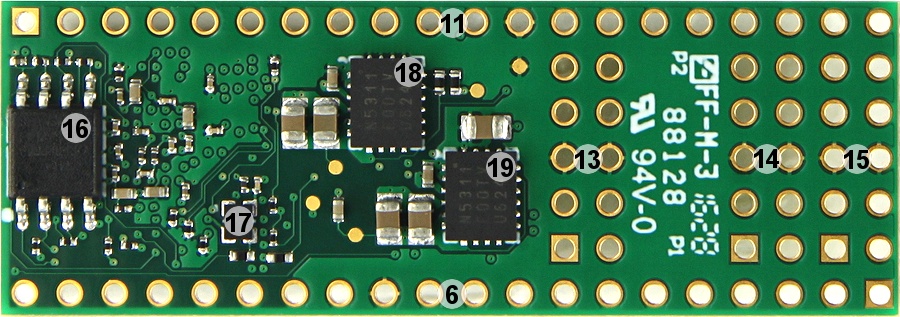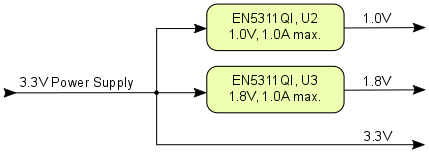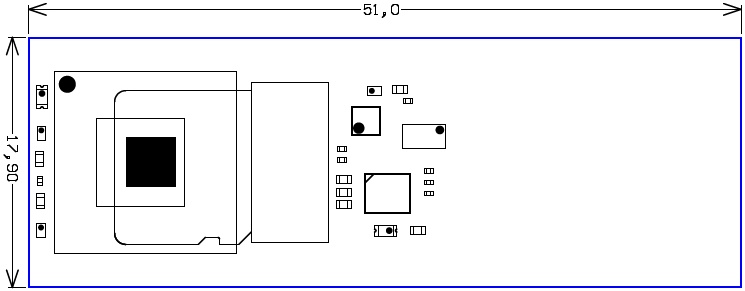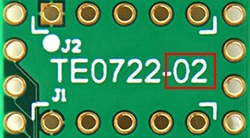Table of Contents
Overview
The Trenz Electronic TE0722-02 is a DIPFORTy1 "Soft Propeller" based on the Xilinx Zynq-7000 SoC.
Key Features
- Xilinx Zynq XC7Z010 SoC
- Dual-core ARM A9+ (TE0722-02-07S-1C variant has single-core ARM A9+)
- 16 MByte Quad SPI Flash
- Micro SD Card socket with card detect signal
- 34 I/Os on DIP40 header pins
- System status LED (DONE)
- RGB LED connected to PL I/O
- Green user LED connected to ARM CPU GPIO
- Proximity and ambient light sensor
- DIP40 form factor (size 18 x 51 mm)
Additional assembly options are available for cost or performance optimization upon request.
Block Diagram
Figure 1: TE022-02 block diagram.
Main Components
Figure 2: TE0722-02 PCB top side.
Figure 3: TE0722-02 PCB bottom side.
- Xilinx Zynq XC7Z010 or Zynq XC7Z007S SoC, U1
- Micro SD card socket with card detect, J8
- Red LED, D3
- Green LED, D2
- Red LED, D6
- 20-pin connector placeholder, P1
- Red LED, D5
- Proximity/ambient light sensor, U4
- RGB LED, D4
- Red LED, D1
- 20-pin connector placeholder, P2
- Ultra-low supply-current voltage monitor, U4
- 2 x 5-pin connector placeholder, J1
- 2 x 5-pin connector placeholder, J2
- 2 x 5-pin connector placeholder, J3
- 16 MByte QSPI Flash memory, U5
- Low-power programmable oscillator @ 33.333333 MHz, U8
- 1A PowerSoC DC-DC converter (1.0V), U2
- 1A PowerSoC DC-DC converter (1.8V), U3
Initial Delivery State
Storage device name | Content | Notes |
|---|---|---|
Quad SPI Flash | Empty |
Table 1: Initial delivery state of programmable devices on the module
Boot Process
The 7 boot mode strapping pins (MIO2 ... MIO8) of the Xiliny Zynq Z-7010 device are hardware programmed on the board. They are evaluated by the Zynq device soon after the 'POR_B'.signal is deasserted to begin the boot process (see section "Boot Mode Pin Settings" of Xilinx manual UG585).
The TE0722 FPGA board is hardware programmed to boot initially from the on-board QSPI Flash memory U5. The JTAG interface of the module is provided for storing the data to the QSPI Flash memory through the Zynq device.
Signals, Interfaces and Pins
I/O Signals on Connectors
Overview of the PL I/O banks signals routed to the external connectors:
| Bank | Type | Connector | I/O Signal Count | Voltage | Notes |
|---|---|---|---|---|---|
| 34 | HR | P1 | 8 | 3.3V | Signal Schematic names: 'P0' - 'P7' |
| 34 | HR | P2 | 8 | 3.3V | Signal Schematic names: 'P24' - 'P31' |
| 34 | HR | P2 | 10 single ended I/O's or 5 differential pairs | 3.3V | - |
| 34 | HR | J1 | 6 | 3.3V | Signal Schematic names: 'X2A' - 'X2F' |
| 34 | HR | J2 | 2 | 3.3V | - |
| 34 | HR | J3 | 4 | 3.3V | Signal Schematic names: 'X1A' - 'X1D' |
| 35 | HR | P1 | 8 single ended I/O's or 4 differential pairs | 3.3V | - |
Table 2: Zynq SoC PL I/O signals overview
Zynq SoC I/O Banks
| Bank | Type | VCCIO | I/O Signal Count | Available on Connectors | Notes |
|---|---|---|---|---|---|
| 34 | HR | 3.3V | 41 | 38 | 38 user I/O's, 3 I/O's used for controlling the RGB LED D4. |
| 35 | HR | 3.3V | 8 | 8 | 8 single ended or 4 differential. |
| 500 | PS MIO | 3.3V | 7 | - | 6 MIO pins used for QSPI flash memory interface, 1 MIO pin connected to green LED D2. |
| 501 | PS MIO | 3.3V | 10 | - | 7 MIO pins used for SD Card interface, 3 MIO pins connected to light sensor U4. |
| 0 | Config | 3.3V | 5 | - | 4 I/O's are dedicated to JTAG interface, 'DONE'-signal is indicated by red LED D6. |
Table 3: General overview of Zynq SoC PL/PS I/O banks
JTAG Interface
JTAG access to the Xilinx ZYNQ XC7Z010 SoC is provided through J2 connector:
JTAG Signal | J2 Connector Pin |
|---|---|
| TCK | 4 |
| TDI | 9 |
| TDO | 10 |
| TMS | 8 |
Table 4: JTAG interface signals
Quad SPI Interface
Quad SPI Flash memory (U5) is connected to the Zynq SoC PS QSPI0 interface via PS MIO bank 500, pins MIO1 ... MIO6:
| Zynq SoC's MIO-pin | U5 Pin | Signal Schematic Name |
|---|---|---|
| MIO1 | 1 | SPI0-CS |
| MIO2 | 5 | SPI0-DQ0/M0 |
| MIO3 | 2 | SPI0-DQ1/M1 |
| MIO4 | 3 | SPI0-DQ2/M2 |
| MIO5 | 7 | SPI0-DQ3/M3 |
| MIO6 | 6 | SPI0-SCK |
Table 5: Quad SPI interface signals and connections
SD Card Interface
TE0722 board has on-board 3.3V SD Card socket (J8) with card detect switch wired to the Zynq SoC PS MIO bank 501, pins MIO28 .. MIO33 and MIO49.
| Zynq SoC's MIO-pin | J8 pin | Signal Schematic Name |
|---|---|---|
| MIO28 | J8-7 | DAT0 |
| MIO29 | J8-3 | CMD |
| MIO30 | J8-5 | CLK |
| MIO31 | J8-8 | DAT1 |
| MIO32 | J8-1 | DAT2 |
| MIO33 | J8-2 | CD/DAT3 |
| MIO49 | J8-G4 | Card detect switch |
Table 6: SD card interface signals
I²C Interface
I2C interface pins SCL and SDA from the Zynq SoC PS MIO-bank 501 (MIO36, MIO37) are connected to ambient / proximity light sensor (U4).
| Zynq SoC's MIO-pin | U4 pin | Signal Schematic Name |
|---|---|---|
| MIO36 | 2 | SCL |
| MIO37 | 1 | SDA |
Table 7: Zynq SoC I2C interface signals
Default PS MIO Mapping
| MIO-pin | Function | Connector to |
|---|---|---|
| MIO1 | QSPI | QSPI flash memory, pin 1 |
| MIO2 | QSPI | QSPI flash memory, pin 5 |
| MIO3 | QSPI | QSPI flash memory, pin 2 |
| MIO4 | QSPI | QSPI flash memory, pin 7 |
| MIO5 | QSPI | QSPI flash memory, pin 3 |
| MIO6 | QSPI | QSPI flash memory, pin 6 |
| MIO7 | GPIO | Green LED D2 |
| MIO28 | SDIO | SD Card socket. pin J8-5 |
| MIO29 | SDIO | SD Card socket. pin J8-3 |
| MIO30 | SDIO | SD Card socket. pin J8-7 |
| MIO31 | SDIO | SD Card socket. pin J8-8 |
| MIO32 | SDIO | SD Card socket. pin J8-1 |
| MIO33 | SDIO | SD Card socket. pin J8-2 |
| MIO36 | I²C | Ambient / Proximity Light Sensor U4, pin 2 |
| MIO37 | I²C | Ambient / Proximity Light Sensor U4, pin 1 |
| MIO39 | GPIO | Ambient / Proximity Light Sensor U4, Interrupt pin 4 |
| MIO49 | GPIO | SD Card socket card detect pin J8-G4 |
Table 8: Default mapping of Zynq PS MIO-bank pins
On-board Peripherals
Quad SPI Flash Memory
On-board QSPI flash memory (U5) is provided by Cypress Semiconductor Serial Flash Memory S25FL127SABMFV101 with 128 MBit (16 MByte) storage capacity. This non volatile memory is used to store initial configuration data. Besides initial configuration data, remaining free flash memory can be used for user application and data storage.
Proximity and Ambient Light Sensor
The TE0722-02 Zynq SoC board is equipped with the Si1143 infrared proximity and ambient light sensor. On-board three red LEDs D1, D3 and D5 are connected to the light sensor to use the proximity sensing functionality. For more details and how to configure and use this chip, refer to the Si1141/42/43 data sheet.
Oscillator
The Zynq SoC board one reference clocking signal as system clock provided by on-board oscillator U8:
| Clock Source | Frequency | Clock Input Destination |
|---|---|---|
| SiTime SiT8008AI Oscillator, U8 | 33.333333 MHz | Zynq PS Bank 500, pin C7 |
Table 9: Clock sources overview
On-board LEDs
There are 6 LEDs fitted on the Zynq SoC board. The LEDs are user configurable to indicate for example any system status.
| LED | Color | Connected to | Signal Schematic Name | Description and Notes |
|---|---|---|---|---|
| D1 | Red | Light sensor U4, pin 6 | - | Proximity sensing functionality of light sensor U4 |
| D2 | Green | Zynq PS bank 500 | MIO7 | user configurable |
| D3 | Red | Light sensor U4, pin 9 | - | Proximity sensing functionality of light sensor U4 |
| D4 | RGB | Zynq PL bank 34, pins J15, L14, K12 | RGB_R, U1, RGB_G, U1, RGB_B, U1 | user configurable |
| D5 | Red | Light sensor U4, pin 7 | - | Proximity sensing functionality of light sensor U4 |
D6 | Green | Zynq config bank 0 | DONE | Reflects inverted DONE signal. ON when FPGA is not configured, |
Table 10: LEDs of the board
Connectors
All connectors are for 100mil (2.54mm pitch) headers, all connector locations are in 100mil grid. The module's PCB provides footprints to mount and solder optional pin headers, if those are not factory-fitted on module.
Power and Power-On Sequence
To power-up a module, power supply with minimum current capability of 1A is recommended.
Power Supply
TE0722-02 needs one single power supply with nominal of 3.3V at all variants. Following diagram shows the dependencies of the power supply:
Figure 4: Module power supply dependencies
Power Consumption
| Board Variant | FPGA | Design | Typical Power, 25°C ambient |
|---|---|---|---|
| TE0722-02I | XC7Z010-1CLG225I | Not configured | TBD* |
| TE0722-02 | XC7Z010-1CLG225C | Not configured | TBD* |
| TE0722-02-07S-1C | XC7Z007S-1CLG225C | Not configured | TBD* |
Table 11: Module power consumption
*TBD - To Be Determined.
The maximum power consumption of the module mainly depends on the design running on the Zynq SoC's FPGA and ambient temperature.
Xilinx provide a power estimator excel sheets to calculate power consumption. It is also possible to evaluate the power consumption of the developed design with Vivado. See also Trenz Electronic Wiki FAQ.
Power-On Sequence
There is no specific or special power-on sequence, single power source is needed as 3.3V as power supply voltage.
Voltage Monitor Circuit
The voltages 1.0V (core voltage) and 3.3V are monitored by the voltage monitor circuit U6, which generates the POR_B reset signal at power-on. A manual reset is also possible by driving the connector pin P1-10 ('NRST') to GND. Leave this pin unconnected or connect to VDD (3.3V) when unused.
Figure 5: Voltage monitor circuit
Power Rails
Power Rail Name | J1 Pins | J2 Pins | J3 Pins | P1 Pin | P2 Pin | Direction | Notes |
|---|---|---|---|---|---|---|---|
| 3.3V | 5, 6 | 5, 6 | 5, 6 | 12 | 12 | Input | 3.3V power supply voltage |
Table 12: Board power rails
Bank Voltages
Bank | Bank I/O Voltage VCCO | Voltage Range |
|---|---|---|
| 0 (config) | 3.3V | fixed |
| 500 (MIO) | 3.3V | fixed |
| 501 (MIO) | 3.3V | fixed |
| 34 (HR) | 3.3V | fixed |
| 35 (HR) | 3.3V | fixed |
Table 13: Board bank voltages
Variants Currently in Production
| Board Variant | Xilinx Zynq SoC | ARM Cores | PL Cells | LUTs | Flip-Flops | Block RAM | DSP Slices | Zynq SoC Operating Temp. | Temp. Range |
|---|---|---|---|---|---|---|---|---|---|
| TE0722-02I | XC7Z010-1CLG225I | A9+ Dual-core | 28K | 17,6K | 35,2K | 2.1 MBytes | 80 | –40°C to +100°C | Industrial |
| TE0722-02 | XC7Z010-1CLG225C | A9+ Dual-core | 28K | 17,6K | 35,2K | 2.1 MBytes | 80 | 0°C to +85°C | Commercial |
| TE0722-02-07S-1C | XC7Z007S-1CLG225C | A9+ Single-core | 23K | 14,4K | 28,8K | 1.8 MBytes | 66 | 0°C to +85°C | Commercial |
Table 14: Board variants
Technical Specifications
Absolute Maximum Ratings
Parameter | Min | Max | Units | Reference Document |
|---|---|---|---|---|
3.3 supply voltage | -0.3 | 3.6 | V | EN5311QI datasheet / Xilinx datasheet DS187 |
| HR PL I/O banks input voltage (VCCIO single ended) | -0.4 | VCCO + 0.55 | V | Xilinx datasheet DS187 (VCCO 3.3V nominal) |
Storage temperature | -40 | +85 | °C | Silicon Labs Si1141/42/43 datasheet. |
Table 15: Board absolute maximum ratings
Recommended Operating Conditions
| Parameter | Min | Max | Units | Reference Document |
|---|---|---|---|---|
| 3.3 supply voltage | 3.3 | 3.465 | V | Xilinx datasheet DS187 |
| HR PL I/O banks input voltage (VCCIO single ended) | -0.20 | VCCO + 0.20 | V | Xilinx datasheet DS187 (VCCO 3.3V nominal) |
Operating Temperature Commercial | 0 | +85 | °C | Xilinx datasheet DS190 |
Operating Temperature Industrial | -40 | +85 | Xilinx datasheet DS190 |
Table 16: Board recommended operating condition
Physical Dimensions
Module size: 17.9 mm × 51 mm. Please download the assembly diagram for exact numbers.
PCB thickness: 1.65 mm.
Highest part on PCB approx. 4 mm. Please download the step model for exact numbers.
All dimensions are given in millimeters.
Figure 6: Board physical dimensions
Revision History
Hardware Revision History
| Date | Revision | Notes | PCN | Documentation Link |
|---|---|---|---|---|
| - | 02 | - | - | TE0722-02 |
| - | 01 | First production release | - | - |
Table 17: Board hardware revision history
Hardware revision number is printed on the PCB board together with the module model number separated by the dash.
Figure 7: TE0722 module hardware revision number
Document Change History
Date | Revision | Contributors | Description |
|---|---|---|---|
Ali Naseri, Jan Kumann |
|
Table 18: Document change history
Disclaimer
Data Privacy
Please also note our data protection declaration at https://www.trenz-electronic.de/en/Data-protection-Privacy
Document Warranty
The material contained in this document is provided “as is” and is subject to being changed at any time without notice. Trenz Electronic does not warrant the accuracy and completeness of the materials in this document. Further, to the maximum extent permitted by applicable law, Trenz Electronic disclaims all warranties, either express or implied, with regard to this document and any information contained herein, including but not limited to the implied warranties of merchantability, fitness for a particular purpose or non infringement of intellectual property. Trenz Electronic shall not be liable for errors or for incidental or consequential damages in connection with the furnishing, use, or performance of this document or of any information contained herein.
Limitation of Liability
In no event will Trenz Electronic, its suppliers, or other third parties mentioned in this document be liable for any damages whatsoever (including, without limitation, those resulting from lost profits, lost data or business interruption) arising out of the use, inability to use, or the results of use of this document, any documents linked to this document, or the materials or information contained at any or all such documents. If your use of the materials or information from this document results in the need for servicing, repair or correction of equipment or data, you assume all costs thereof.
Copyright Notice
No part of this manual may be reproduced in any form or by any means (including electronic storage and retrieval or translation into a foreign language) without prior agreement and written consent from Trenz Electronic.
Technology Licenses
The hardware / firmware / software described in this document are furnished under a license and may be used /modified / copied only in accordance with the terms of such license.
Environmental Protection
To confront directly with the responsibility toward the environment, the global community and eventually also oneself. Such a resolution should be integral part not only of everybody's life. Also enterprises shall be conscious of their social responsibility and contribute to the preservation of our common living space. That is why Trenz Electronic invests in the protection of our Environment.
REACH, RoHS and WEEE
REACH
Trenz Electronic is a manufacturer and a distributor of electronic products. It is therefore a so called downstream user in the sense of REACH. The products we supply to you are solely non-chemical products (goods). Moreover and under normal and reasonably foreseeable circumstances of application, the goods supplied to you shall not release any substance. For that, Trenz Electronic is obliged to neither register nor to provide safety data sheet. According to present knowledge and to best of our knowledge, no SVHC (Substances of Very High Concern) on the Candidate List are contained in our products. Furthermore, we will immediately and unsolicited inform our customers in compliance with REACH - Article 33 if any substance present in our goods (above a concentration of 0,1 % weight by weight) will be classified as SVHC by the European Chemicals Agency (ECHA).
RoHS
Trenz Electronic GmbH herewith declares that all its products are developed, manufactured and distributed RoHS compliant.
WEEE
Information for users within the European Union in accordance with Directive 2002/96/EC of the European Parliament and of the Council of 27 January 2003 on waste electrical and electronic equipment (WEEE).
Users of electrical and electronic equipment in private households are required not to dispose of waste electrical and electronic equipment as unsorted municipal waste and to collect such waste electrical and electronic equipment separately. By the 13 August 2005, Member States shall have ensured that systems are set up allowing final holders and distributors to return waste electrical and electronic equipment at least free of charge. Member States shall ensure the availability and accessibility of the necessary collection facilities. Separate collection is the precondition to ensure specific treatment and recycling of waste electrical and electronic equipment and is necessary to achieve the chosen level of protection of human health and the environment in the European Union. Consumers have to actively contribute to the success of such collection and the return of waste electrical and electronic equipment. Presence of hazardous substances in electrical and electronic equipment results in potential effects on the environment and human health. The symbol consisting of the crossed-out wheeled bin indicates separate collection for waste electrical and electronic equipment.
Trenz Electronic is registered under WEEE-Reg.-Nr. DE97922676.
